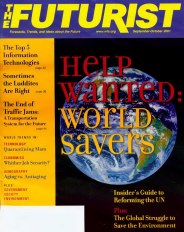10905
0
Posted on Nov 07, 2003, 6 a.m.
By Bill Freeman
Aging versus AntiagingGeriatrics is in trouble while antiaging medicine takes off Reprinted from The Futurist (World Future Society)Authored by Cythia Wagner, Managing Editor, The Futurist. Originally published in the September-October 2001 issue of THE FUTURIST. Used with permission from the World Future Society, 7910 Woodmont Avenue, Suite 450, Bethesda, Maryland 20814 USA.
Aging versus AntiagingGeriatrics is in trouble while antiaging medicine takes offReprinted from The Futurist (World Future Society)Authored by Cythia Wagner, Managing Editor, The Futurist. Originally published in the September-October 2001 issue of THE FUTURIST. Used with permission from the World Future Society, 7910 Woodmont Avenue, Suite 450, Bethesda, Maryland 20814 USA. Telephone: 301/656-8274; Fax: 301/951-0394; www.wfs.org .
There is an urgent need to increase the number of practicing geriatricians in the United States, according to the American Geriatrics Society. The aging baby-boom generation is bringing a potential medical crisis to the fore: a critical lack of doctors who specialize in treating elderly patients.
Geriatric medicine offers comprehensive health care for frail elderly, promoting wellness and preventive care to give them more independence and prevent unnecessary, expensive trips to hospitals and nursing homes. Geriatricians are board certified in family practice or internal medicine, then complete additional training in geriatrics

In the next 30 years, 70 million Americans will be age 65 or older, but the number of certified geriatricians is expected to decline dramatically from the fewer than 9,000 practicing today, according to the American Geriatrics Society.
U.S. Senator Blanche Lincoln of Arkansas recently introduced legislation to help increase the number of geriatricians through training incentives and Medicare reimbursement. The Geriatric Care Act of 2001 would authorize Medicare to cover essential services for seniors such as geriatric assessment and care coordination, which would allow the geriatrician to manage medications more effectively and to work with other health-care providers as a team. It would also allow additional geriatric training slots in teaching hospitals. Geriatric training was dropped from many programs in the late 1990s due to legislated budget cuts.
"Our country teeters on the brink of revolutionary demographic change as baby boomers begin to retire and Medicare begins to care for them," says Lincoln. "Our nation's health-care system will face an unprecedented strain as our population grows older. Demand for quality care will increase, and we will need physicians who understand the complex health problems that aging inevitably brings."
Geriatrics may also be suffering from competition arising in a new health-care subspecialty: antiaging. The American Academy of Anti-Aging Medicine (A4M), founded in 1993, now boasts 10,000 members, 80% of whom are physicians. Rather than treating the problems of frail elderly, the mission of antiaging physicians and researchers is to slow, stop, and reverse the processes that make elderly people frail in the first place. This represents "a profound shift in the way the medical field approaches human aging," according to A4M's mission statement.
Antiaging medicine is "the fastest growing medical specialty of the twenty-first century," according to A4M. The Academy's two certification boards test and certify doctors, chiropractors, dentists, pharmacists, nurses, and other health-care providers in antiaging medicine. To date, 600 physicians and other health practitioners have been certified.
Both geriatrics and antiaging aim to improve the quality of life among the elderly, but antiaging is more specifically focused on extending the number of years in which to have a higher quality of life. This new focus may simply reflect a subtle realignment of priorities from the problems of the elderly to the opportunities of longer lives.
But longer lives are already causing more-complex problems for the elderly. "As seniors live longer, they face much greater risks of disease and disabilities," notes Lincoln. "Conditions such as heart disease, cancer, stroke, diabetes, and Alzheimer's disease occur more frequently as people age. The complex problems associated with aging require a supply of physicians with special training in geriatrics. Geriatrics is a vital thread in the fabric of our health-care system, especially in light of our looming demographic changes."
| Elder Medicine | Trend | |
|---|---|---|
| 34,835 | Persons age 65 (U.S.) in 2000; 70,319 in 2030 | UP |
| 9,000 | Certified geriatricians | DOWN |
| 600 | Certified antiaging practitioners | UP |
| 10,000 | Members of the American Academy of Anti-Aging Medicine | UP |
Sources:
The American Geriatrics Society, The Empire State Building, 350 Fifth Avenue, Suite 801, New York, New York 10118 USA. Telephone 212-308-1414; Web site www.americangeriatrics.org.









